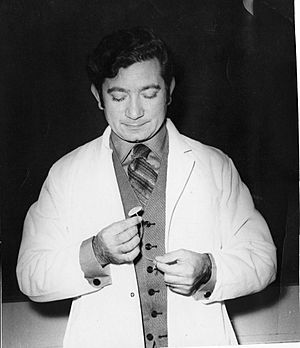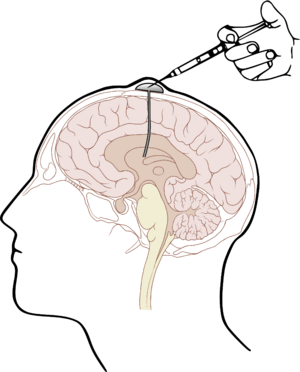Ayub Ommaya facts for kids
Quick facts for kids
Ayub Khan Ommaya
|
|
|---|---|
 |
|
| Born | April 14, 1930 Mian Chanu, Punjab, British India
|
| Died | July 11, 2008 (aged 78) |
| Occupation | Neurosurgeon |
| Known for | Innovative surgeon, Ommaya reservoir |
Ayub Khan Ommaya (1930 – 2008) was a Pakistani American brain surgeon, also known as a neurosurgeon. He invented a special device called the Ommaya reservoir. This device helps deliver medicine directly to brain tumors. Dr. Ommaya was also a top expert in treating serious head injuries.
He wrote over 150 articles, chapters, and books. His work focused on treating cancer, understanding brain injuries, and even creating an artificial organ. He also helped create the National Center for Injury Prevention and Control in the US. This center helps prevent injuries, including brain injuries.
Dr. Ommaya's research helped us understand how brain injuries happen. His "Centripetal theory" was very important for studying brain injury mechanics. This work helped engineers design safer cars and protective gear.
He also worked with early computed tomography (CT) scanners. His work helped doctors use CT scans for very precise brain surgery. Dr. Ommaya also helped pioneer spinal angiography. This technique lets doctors see arteries and veins in the spine. It helped them understand and treat problems in the spinal cord.
Contents
A Doctor's Journey
Ayub Ommaya earned his medical degree in Pakistan in 1953. He then studied at the University of Oxford in England as a Rhodes Scholar. While there, he studied physiology, psychology, and biochemistry. He was also a national swimming champion in Pakistan in 1953. He was a great debater and even trained as an opera singer!
In 1961, Dr. Ommaya moved to the United States. He became a US citizen in 1967. He later received an honorary Doctor of Science degree in 1981.
From 1961 to 1980, he worked at the National Institutes of Health (NIH). He became the Chief of Neurosurgery there. He studied cancer treatments, how brain injuries happen, and memory. From 1980 to 1985, he was a top medical advisor for the United States Department of Transportation. He also taught at George Washington University until 2003. He returned to Pakistan in 2005.
Dr. Ommaya held patents for devices that deliver medicine to the brain. He also had patents for systems that protect the head and neck from injuries. He even had a patent for an artificial organ to treat diabetes.
He received the Sitara-i-Imtiaz award from the President of Pakistan in 1982. This is a very high honor.
Skilled Brain Surgeon
Dr. Ommaya completed his brain surgery training in London and Oxford. After his training, he moved to America. He started working as a researcher and doctor at the NIH. He became the Chief of Neurosurgery at the National Institute of Neurological Disorders and Stroke. He also taught as a clinical professor at George Washington University.
He was known for his amazing surgical skills. In 1977, he performed a very difficult 18-hour surgery. The patient's body temperature was lowered to protect their brain. This allowed Dr. Ommaya to remove a complex problem near the brainstem. He was also the honorary physician to the President of Pakistan. Dr. Ommaya even appeared in the 1992 movie Lorenzo's Oil.
Many Important Firsts
Dr. Ommaya's invention, the Ommaya reservoir, was a major breakthrough. It was the first device placed under the skin that allowed doctors to give repeated medicine injections directly into the brain's fluid. Before this, patients needed painful spinal taps every time.
He also helped pioneer spinal angiography. This allowed doctors to see blood vessels in the spine. His team also treated spinal cord problems using tiny metal pellets. This was one of the first times doctors used this kind of "interventional neuroradiology." It meant treating problems without big open surgery.
Dr. Ommaya's work on brain injuries was very important. His models helped engineers design safer cars and helmets. He also created the first way to score how serious a traumatic brain injury was. Modern systems still use his ideas. His friendship with Congressman William Lehman led to the creation of the National Center for Injury Prevention and Control.
He worked with Sir Godfrey Hounsfield on the CT scanner. Their work helped doctors use CT scans for very precise surgeries. Dr. Ommaya also invented the first artificial organ powered by spinal fluid.
Understanding Brain Injuries
Dr. Ommaya's "centripetal theory" explained how brain injuries affect the brain. He showed that mild injuries affect the brain's surface. More severe injuries go deeper into the brain. His work proved that twisting forces (rotational acceleration) cause more widespread damage. This includes a type of injury called diffuse axonal injury. This was different from what many believed before. His theories have been supported by modern MRI scans.
The Ommaya Reservoir
Dr. Ommaya first described the Ommaya reservoir in 1963. It's a small device placed under the skin. It helps deliver medicine directly into the fluid around the brain and spinal cord. It's used to treat conditions like hydrocephalus (too much fluid in the brain) and brain tumors. The reservoir was the first medical device to use silicone. Silicone is safe for the body and can seal itself after injections. It allows doctors to give chemotherapy directly to the tumor.
Creating a Center for Injury Prevention
While working for the Department of Transportation, Dr. Ommaya asked for a special report. This report, called "Injury in America," came out in 1985. This report, along with efforts by Dr. Ommaya and Congressman William Lehman, led to the creation of the National Center for Injury Prevention and Control. This center, part of the Centers for Disease Control (CDC), helps guide and fund injury research. Dr. Ommaya and Congressman Lehman became friends. They often talked about the need for a center focused on preventing injuries. The Congressman helped get the first $10 million for the center. Today, the center's budget is much larger, funding important research. Dr. Ommaya served on the center's advisory committee for 15 years.
Artificial Organ for Diabetes
Dr. Ommaya was interested in treating diabetes. He wanted to transplant special cells (islet cells) that make insulin. A big problem with transplants is the body's immune system attacking the new cells. Dr. Ommaya thought the fluid around the brain (CSF) might protect these cells. He developed an artificial organ to hold the transplanted cells. The CSF would nourish them. His research showed that these cells could survive in this system in animals. More work is still needed on this idea.
Emotions and Consciousness
Dr. Ommaya spent much of his career studying consciousness, the brain, and the mind. His interest came from reading about brain surgery for epilepsy. His work on brain injuries also made him think about how consciousness changes and recovers after an injury. He believed that emotions and the limbic system (a part of the brain) are very important for consciousness. He thought emotions trigger actions, and our thoughts help us understand those actions. Dr. Ommaya saw consciousness as something that developed as the brain evolved.
Many people think emotions get in the way of clear thinking. But Dr. Ommaya's research showed that emotions are a basic part of how we think. He described four steps in how consciousness developed. He explained how emotions motivate us and help us focus our attention.
Personal Life
Ayub Ommaya had six children: David, Alex, Shana, Aisha, Iman, and Sinan. He is survived by his wife, Ghazala.
He was mentioned in an article called "The Muslims who shaped America." A review in 2017 highlighted his important contributions to medicine and brain surgery.
On July 13, 2008, a Pakistani newspaper reported his death. They called him a "trailblazing Pakistani surgeon." News of his passing was also shared in European and US publications.


